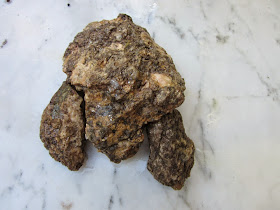I think the house was built over time, put here by the Pomperauge Plantation, regarded as John Minor's property perhaps, since he was the Indian Interpreter and Military leader of the group, keeping an eye on the Nonnewaug Wigwams, waiting to acquire those already cleared floodplain fields, waiting for the big move that I infer happened in that year of 1734, when Indigenous People began to gather together at Schaghticoke.
The property has some stone features, furniture of the cultural landscape (a Ceremonial Stone Landscape) present before 1700 that includes rows of stones and stone heaps. Much of the newer stone work around here has been borrowed from the older since it is very easy to do so and reused since around 1700, fancy work to fill and everything in between. Such as a garden border or some cement steps. It would be an impossible Humpty Dumpty Situation to try to put anything back together, but I am in the habit of placing found stones of the same color together here and there on a stone wall or in my garden, although some of the really striking ones sit on a shelf or two inside. Sometimes they are found right together, as if picked up at the same time from one of the stone piles in the yard and put down together once again.
Two interesting moments occurred just this week.
This bunch came from a former garden border; I had noticed a possible turtle shell and head resemblance - especially the back edge that could be said to greatly resemble a snapping turtle. A year or more later I thought I'd put the two other similar stones with it, as if to resemble forelegs:
The second was earlier in the week at some crumbling cement steps made in the 1960's, same sort of stone, oddly enough, but given the same sort of trial placement as testudinate:









No comments:
Post a Comment